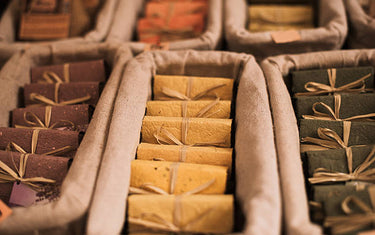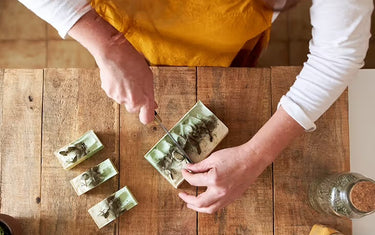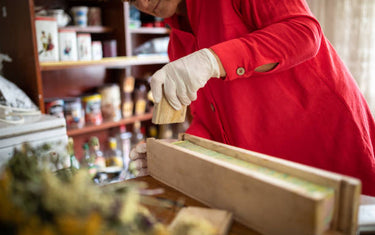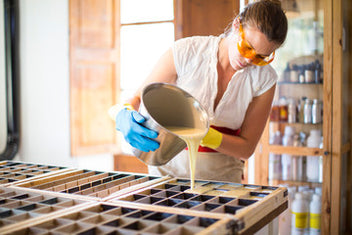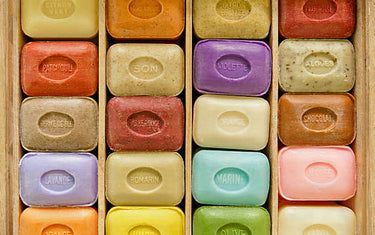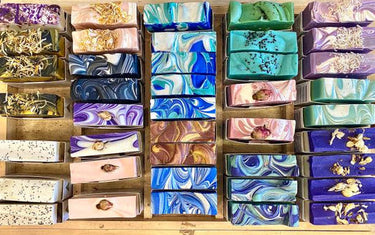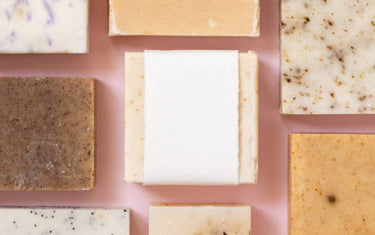9 min read / 1 October 2024 / yasmin sharp
4. Soap Ingredients and Additives
Discover the essentials of soap making with our comprehensive guide on oils, lye, fragrances, colourants, and botanicals for beautiful, effective soaps.
Share this post
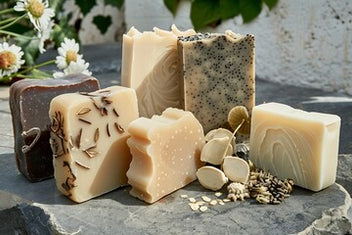
Section 2: Lye Types and Handling
Section 3: Fragrance Oils vs Essential Oils
Section 4: Colourants and Exfoliants
Section 5: Herbs and Botanicals
A key part of creating and selling natural soap is getting to grips with the ingredients you need to create a high-quality product.
Fat, water and lye are the essentials, and there are a host of herbs, exfoliants, fragrance oils, essential oils or colourants you can add to make something truly unique.
Our guide to soap making for beginners looks at the soap ingredients and additives you can experiment with and the important role they play, including the best ways of incorporating natural soap additives while maintaining the quality of the soap.

Section 1: Oils and Butters
Introduction to Oils and Butters
All soaps need an oil or butter to enhance the moisturising and lathering properties and to influence the overall design of the bar.
We explain some of the more common varieties of oils and butters you could include in your recipe.
Common Oils
- Olive Oil: Olive oil is ideal for milder soaps and is kinder to skin because it helps to retain natural moisture to keep it soft and supple.
- Coconut Oil: This helps to create an excellent lather and is best suited for people who do not suffer from dry skin.
- Palm Oil: Palm oil is used to make a good, hard soap that still cleanses without being too harsh on skin.
- Sunflower Oil: Another option for skin-friendly soaps due to its high vitamin E content, which helps to moisturise the skin.
Popular Butters
- Shea Butter: The nourishing and moisturising properties of shea butter make it good for skin, whilst adding a nice creamy colour to the soap.
- Cocoa Butter: Another high-quality skin softener, cocoa butter helps to harden the soap bar and also retains the moisture to the skin.
- Mango Butter: Adding mango butter adds to the hardness and creaminess of the bar, whilst helping to hydrate and rejuvenate the skin.

Section 2: Lye Types and Handling
What is Lye?
Lye is an alkaline chemical and is a term used to refer to Sodium Hydroxide (NaOH) and Potassium Hydroxide (KOH). When using lye in soap making it is blended into a mixture to make a solution for the saponification process, where the oils, fats and lipids are turned into the soap base.
Types of Lye
Sodium Hydroxide (NaOH): Sodium hydroxide in soap making is the most common choice, as it is less expensive than potassium hydroxide. However, it is more caustic, so extra care is needed when being handled.
Potassium Hydroxide (KOH): KOH is sometimes referred to as caustic potash and is another strong alkaline. It shares a lot of similarities with NaOH, although there is a slightly smaller amount of sodium hydroxide, which allows it to cut through oil molecules a little faster.
Safe Handling of Lye
- Safety Gear: When using lye in soap making, always wear rubber or plastic gloves, eye protection (goggles) and clothing that covers your arms and legs to protect against spills and splashes. You should also ensure that your feet are covered when handling lye.
- Proper Mixing Techniques: When mixing, use a non-reactive mixing bowl made from glass or stainless steel. Put down a plastic sheet to protect work surfaces from being stained or discoloured.
- Storage Tips: Store the lye in a rigid container, ensuring it is sealed tightly and clearly labelled. Always keep the lye store in a space that is not easily accessible. Keep away from direct heat and light sources in a cool, dry area.
Lye Calculation
The easy way to calculate how much lye you will need for your recipe is to multiply the total weight of the oils by the lye concentration.
For example, if you are using 15% lye concentration in your recipe and 48 ounces of oils, you would multiply 0.15 by 48 to get 7.2 ounces of lye.

Section 3: Fragrance Oils vs Essential Oils
Introduction to Fragrances in Soap
Adding fragrance oils or essential oils to your soaps can be transformative for your products, helping to enhance the aesthetic and overall experience for the user. We discuss the difference between fragrance oils and essential oils for soap and how they can each be used to your benefit.
Fragrance Oils
- Characteristics: Fragrance oils – also referred to as perfume oils - are made synthetically by perfumers and chemists to create a wide range of unique scents.
- Benefits: One of the most notable benefits of fragrance oils is their longevity. Their synthetic composition allows their scent to last for longer, compared to essential oils.
- Potential Issues: As is true with essential oils, care should be taken when handling fragrance oils due to their high potency. They should always be diluted with a carrier oil before skin application and a patch test performed to check for potential allergies and reactions.
Essential Oils
- Characteristics: Essential oils are extracted from natural sources and, in their purest form, are highly concentrated. This makes them extremely aromatic and easy to blend with carrier oils to create natural, skin-safe scents.
- Benefits: They offer a host of health benefits, with some providing vitamin E and skin moisturising properties, whilst some can improve complexion, skin elasticity, and help to combat the signs of ageing. This makes many essential oils a great choice for creating homemade moisturising soap.
- Potential Issues: Due to their highly concentrated nature, essential oils may not be suited to people with sensitive skin. If you are selling soaps that contain essential oils, appropriate warnings should be added to the packaging, so customers are aware of the potential risks.
Comparison
- Cost: Due to the manufacturing process, essential oils tend to be more expensive than fragrance oils. Although they are natural oils, the extraction process is more resource-intensive, which adds to the cost.
- Strength of Scent: Fragrance oils usually have a stronger scent than essential oils as they are made using mostly synthetic ingredients. Essential oils are distilled from natural sources, so the scent does not linger as long.
Natural vs Synthetic
When it comes to deciding between fragrance oils vs essential oils, it often comes down to personal choice. Essential oils are more natural and contain a host of health properties, whilst fragrance oils offer unique scents that can evoke rare memories.
If the ethos of your soapmaking brand is centred on being eco-friendly, then essential oils may be the better choice, or if you want something more focused and specialised, then fragrance oils are probably the way to go.

Section 4: Colourants and Exfoliants
Introduction to Colourants
Using natural soap colourants in the soap making process can make the product more fun and appealing to customers, whilst also giving you many more creative options. And the type of colourant you use will influence the stability and longevity of the soap’s final colour.
Types of Colourants
- Natural Colourants: Natural soap colourants come from natural sources, such as clay or herbs and spices. They are kind on skin and available in a variety of shades that make them ideal for use in soapmaking.
- Synthetic Colourants: Some people prefer to use synthetic colourants as they can offer more consistency and hold the tone for longer. They are just as safe to use on skin and offer the option to include more specific colour shades in your products.
Introduction to Exfoliants
Exfoliants are soap making ingredients that are included to cleanse and balance out skin. They are salts and sugars that support better exfoliation, while also enhancing the lathering abilities.
Common Exfoliants
- Oatmeal: Oats are a popular exfoliant in soap, helping to remove dead skin cells while acting as a natural cleanser, thanks to the presence of saponins.
- Coffee Grounds: Coffee is rich in antioxidants, with the grounded variety working well as an exfoliant when added to soap. It can also offer benefits for sensitive or sunburnt skin.
- Poppy Seeds: Not only do poppy seeds create an elevated aesthetic for your soap, but as an exfoliant they can help to scrub away dead skin, dirt and oil.
Techniques for Adding Colour and Exfoliants
- Timing and Method: When adding colour or exfoliants as soap making ingredients, timing is crucial. Depending on whether you are using the melt and pour or cold process soap making, there are differences in the timing and temperature points, so check the recipe closely to ensure these are added at the correct times.
- Dos and Don'ts: Try to use colourant dyes sparingly as it can lead to staining. Subtle use of colours will help to avoid bleeding, so you have more control over the finished product. Grind down exfoliants like coffee and oats before adding them to your recipe, and only use a small percentage so they do not overpower the other scented elements of your soap.

Section 5: Herbs and Botanicals
Introduction to Herbs and Botanicals
The natural healing properties provided by herbs and botanicals can make them a powerful addition to your soap recipe. They also give you more variety for your soaps, whilst being packed with an array of calming scents and skin-friendly elements.
Common Herbs and Botanicals
- Lavender: Lavender buds bring decorative flair and added texture to your soap bar. The calming scent of lavender is also one that lasts, and it can be added in whole form to the top of the bar and for exfoliation.
- Chamomile: Another popular addition are chamomile flowers, which have a relaxing scent and a variety of natural properties that can benefit the skin. It’s a versatile herb that also blends well with lotions, creams and bath teas.
- Calendula: Bright and yellow in colour, calendula petals bring a floral and citrusy aroma, making them the perfect addition to homemade soaps. It adds a delightful yellow tint to the soap and provides soothing qualities for skin application.
Methods of Incorporation
- Infusions: The cold infusion method involves leaving the herbs inside a jar with the oils for 2-6 weeks, to let the scent gradually soak in. The heat infusion method is faster, taking only a few hours, as you simply add the herbs to the oils in a saucepan and gradually heat through.
- Powders: You can mix the herbal powder straight into your essential oil or fragrance oil to create a paste. Add this to the melted soap base and mix well until the ingredients are fully infused.
- Whole Herbs: Some people prefer to add dry herbs and botanicals at the end of the process. Once the melted base is ready, place the dried herbs at the bottom of your moulds in a decorative pattern. Pour the soap into the moulds and leave to dry and set.
Considerations
- Shelf Life: A lot of dried flowers will retain their original colours for several months if they are used as decorations on top of the soap. The deeper the herbs or botanicals are pushed into the soap, the more moisture they will collect. Sometimes, waiting 2-3 days for the pH to drop as the soap dries can also help with colour preservation.
- Potential Allergens: Adding herbs and/or botanicals to your soaps can increase the allergen risk for users. Take this into account when creating the warning labels and ingredient information for the packaging, so customers are aware of the full contents of the product. Take this into account when creating the warning labels and ingredient information for the packaging of botanical and herbal soaps, so customers are aware of the full contents of the product.
Additives for Melt and Pour Soap
When using additives for melt and pour soap, it's important to know that these bases have a lower tolerance for additional ingredients than cold process soaps, and their pre-made nature comes with some restrictions.
Careful temperature control is important and fresh ingredients and water-based additives should be avoided in melt and pour due to spoilage concerns. Exfoliants can sink in melt and pour because of its thinner consistency, whereas cold process soap better suspends these additives.
When used in the appropriate measurements, fragrance oils behave more predictably in melt and pour without causing issues like acceleration or seizing that can occur in cold process methods.

Conclusion
Soap making ingredients are wide and varied, which means there are almost no limits to how creative you can be.
From choosing the right oils, lye and fragrances, to selecting the best colours, herbs and exfoliants, you can ensure your soap products really make a splash.
When starting out, the only way you’ll really know what works best is to experiment and try out new ideas.
You’ll quickly discover the things you like and the parts you don’t, and you’ll soon be on the path towards crafting eye-catching soap products.
You may find it helpful to read more about the basics of soap making in our in-depth guide and to familiarise yourself with the full process of soap making. We also have a host of articles that can give you valuable advice about setting up and running a soap business from home.
For those looking to start their own soap making business, consider signing up for a Nikura wholesale account for significant discounts on the supplies you’ll need along the way.


